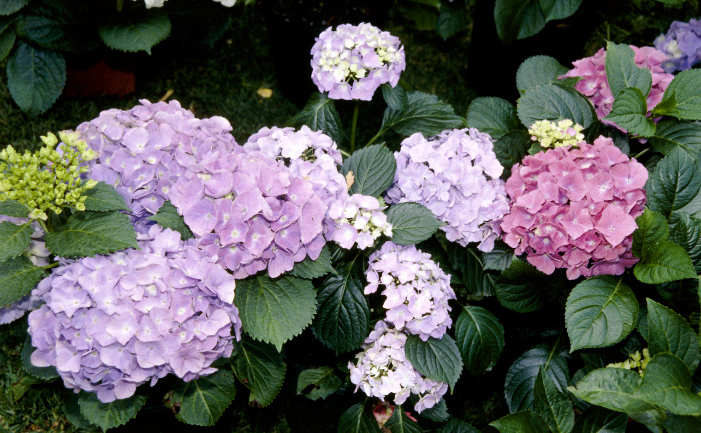Fact Sheet: Hydrangeas
Hydrangeas are wonderful, hardy shrubs that would certainly have to be included on a list of the ten best flowering plants in the world. Some people remember hydrangeas growing in their grandmother’s garden, and think of them as old fashioned plants. Those old varieties did have one downside: a lot of them tended to be too tall and lanky. The great news is that in recent years plant breeders have developed some excellent new varieties which are more compact and come in a range of sizes.
Size
Old fashioned varieties such as Hydrangea macrophylla ‘Ayesha’ grow about 1.5-2m (5-7′) tall or more, and can look floppy. Medium growers including the white flowered Hydrangea macrophylla ‘Bichon’ reach about 1.5m (5′) tall. They are more compact and have more flowers. Dwarf varieties like Hydrangea macrophylla ‘Blauer Zwerg’ (usually sold as ‘Lavblau’) only grow to around 1m (3′) tall. Flowers cover the whole bush. Mini growers are perfect for balconies. For example Hydrangea macrophylla ‘Pia Mina’ has pink flowers and grows to 60cm (24″) high.
Blue or pink?
Hydrangeas are amazingly versatile in that you can actually alter the flower colours to suit your needs. The flower colour in most forms relates to the acidity or alkalinity of the soil. In acid soil (pH 5 or less) hydrangeas are usually always blue. As the soil pH climbs towards the neutral and alkaline end of the scale (pH 7 or more) hydrangeas turn mauve, pink and red. A blueing tonic (containing aluminium and iron) will turn pink or mauve hydrangeas blue. It should be applied once a month in March and April and again in August, September and October, following the directions on the pack. A cup of lime (calcium carbonate) added to the soil in spring will cause blue or mauve hydrangeas to turn pink. White flowering hydrangeas will remain white regardless of soil pH.
Care
For ease of growth hydrangeas are best in a semi shaded position, but some hardy varieties will tolerate full sun. The most important thing to remember is not to let them dry out, or they will wilt. They need regular watering, particularly in late spring and through summer. Give hydrangeas growing in the ground a deep soaking once or twice a week. Plants in pots need daily watering and it’s a good idea to have a saucer containing water under the pot.
Pruning
In most areas hydrangeas can be pruned in March or April. Don’t cut back into old grey wood. If hydrangeas are pruned too fiercely year after year flowering will be reduced to 10% or less, so just cut back the green, current season’s growth to two plump eyes or leaf buds. Leave stems that have not flowered as these will flower the following season. If you want to pick the flowers for indoor arrangements by all means do so, that is really good for the plants. Some of the modern varieties are naturally compact and need less pruning.
Getting started
Hydrangeas are sold in flower at nurseries throughout the early summer months (December and January). They are available in 200mm (8″) pots for about $16, up to 300mm (12″) pots for $60. Hydrangeas also strike very easily from soft tip or hardwood cuttings.



